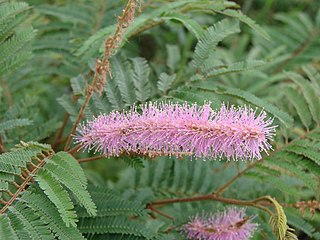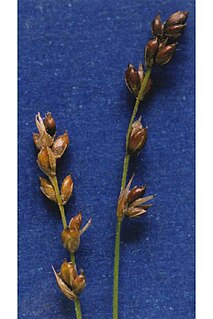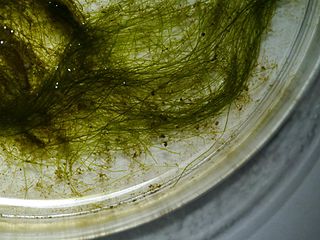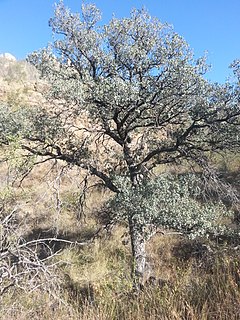
Mimosa is a genus of about 400 species of herbs and shrubs, in the mimosoid clade of the legume family Fabaceae. The generic name is derived from the Greek word μῖμος (mimos), an "actor" or "mime", and the feminine suffix -osa, "resembling", suggesting its 'sensitive leaves' which seem to 'mimic conscious life'.

Albizia is a genus of more than 160 species of mostly fast-growing subtropical and tropical trees and shrubs in the subfamily Mimosoideae of the family Fabaceae. The genus is pantropical, occurring in Asia, Africa, Madagascar, America and Australia, but mostly in the Old World tropics. In some locations, some species are considered weeds.

Mimosa pudica is a creeping annual or perennial flowering plant of the pea/legume family Fabaceae. It is often grown for its curiosity value: the compound leaves fold inward and droop when touched or shaken, defending themselves from harm, and re-open a few minutes later. In the UK it has gained the Royal Horticultural Society's Award of Garden Merit.

The streak-backed oriole is a medium-sized species of passerine bird from the icterid family. It is native to Central America and Mexico and is an occasional visitor to the United States.

Colletia is a genus of flowering plants in the family Rhamnaceae, with 5 species of spiny shrubs. All species of this genus are native to southern South America. They are non-legume nitrogen fixers.

Albizia lebbeck is a species of Albizia, native to Indomalaya, New Guinea and Northern Australia and widely cultivated and naturalised in other tropical and subtropical regions. English names for it include lebbeck, lebbek tree, flea tree, frywood, koko and woman's tongue tree. The latter name is a play on the sound the seeds make as they rattle inside the pods. Being one of the most widespread and common species of Albizia worldwide, it is often simply called siris, though this name may refer to any locally common member of the genus.

Mimosa diplotricha is a species of leguminous woody shrub native to the Neotropics. It is an invasive species and now has a pantropical distribution. It is commonly known as the giant sensitive plant, giant false sensitive plant, or nila grass.
Albizia pistaciifolia is a species of plant in the family Fabaceae. It is found in Colombia, Ecuador, and Venezuela.
Mimosa andina is a species of plant in the family Fabaceae. It is found only in Ecuador. Its natural habitat is subtropical or tropical dry shrubland.
Mimosa loxensis is a species of plant in the family Fabaceae. It is found only in Ecuador. Its natural habitat is subtropical or tropical dry shrubland.
Mimosa nothacacia is a species of plant in the family Fabaceae. It is found in Ecuador and Peru.
Mimosa townsendii is a species of plant in the family Fabaceae. It is found only in Ecuador. Its natural habitat is subtropical or tropical dry shrubland.

Mimosa verrucosa, commonly known as jurema-branca or jurema-de-oeiras, is a species of legume of the genus Mimosa, in the common bean family, Fabaceae.

Archidendron bigeminum is a tree species in the legume family (Fabaceae). It is found in India and Sri Lanka. It is known as "Kalitiya - කලටිය" in Sinhala people.
Discocharopa mimosa is a species of air-breathing land snails, terrestrial pulmonate gastropod molluscs in the family Charopidae. This species is endemic to Australia.

Carex disperma is a species of sedge known by the common names softleaf sedge or two-seed sedge. It is native to much of the northern Northern Hemisphere, from Alaska to Greenland, most of Canada and the contiguous United States, and across Eurasia.

Vaucheria is a genus of Xanthophyceae or yellow-green algae. It is one of only two genera in the family Vaucheriaceae. The type species of the genus is Vaucheria disperma.
Crispiloba is a monotypic genus of flowering plants containing the single species Crispiloba disperma, native to Queensland in Australia. Crispiloba disperma is a shrub species that grows to 4 metres tall. It produces fragrant white flowers followed by purplish ovoid fruits. It occurs in rainforest in North-east Queensland at altitudes ranging from 100 to 1250 metres. The species was first formally described in 1917, based on plant material collected from Mount Bellenden Ker. It was originally given the name Randia disperma and subsequently transferred to the genus Crispiloba in 1984.

Quercus oblongifolia, commonly known as the Arizona blue oak, Blue live oak or Sonoran blue oak, is an evergreen small tree or large shrub in the white oak group.

The Oti Valley Faunal Reserve is a protected area in northeastern Togo, one of four Important Bird Areas (IBA) in the country. The site is mainly savanna and seasonally inundated floodplains on either side of the Oti River. It has a total area of 147,840 hectares and is located at 10°35'N and 0°40'E.













